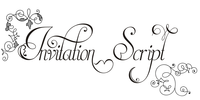Download Invitation Script Font Family Style
Download Invitation Script Font Family

Iza W and Intellecta Design are proud to announce Invitation Script, a modern and clean revival of the classic work of the Portuguese master penman Manuel de Andrade de Figueiredo, whose work can be seen in Nova Escola para aprender a ler, escrever, e contar (...)'' (1722).
Invitation Script is the third script superfamily published by Intellecta Design, after Penabico and Van den Velde Script.
Invitation Script has original letters designed by Iza W.
Creative direction and core programming were provided by Paulo W. Chyrllene K assisted with some work on unusual and archaic styles, resulting in a special font - Invitation Script Archaic (soon available).
More…
Invitation family includes two multi-table Opentype fonts, three supplementary fonts for ornaments and fleurons, and the Archaic font with some of the Andrades original characters.
Over 40 variations are available for certain letters via the Special Sets Opentype table.
These are accessible via contextual alternates and other open-type features.
Additional ornaments can be found in the two Invitation Script Ornaments fonts.
We recommend exploring the magic of this font using the glyph palette.
Let your imagination go wild and use Invitation Script in ways that Andrade could not have foreseen.
Offerecida Augusta Magestade do Senhor Dom Joa V. Rey de Portugal. Primeira parte / por Manoel de Andrade de Figueiredo, Mestre desta Arte nas cidades de Lisboa Occidental, e Oriental.
- Lisboa Occidental: na Officina de Bernardo da Costa de Carvalho, Impressor do Serenissimo Senhor Infante, 1722. - [18], 156 p., 44 f. grav. a buril : il., ; 2 (31 cm)Engraved royal coat of arms supported by angels over the city of Lisbon, engraved portrait of the author (both of the foregoing by Bernard Picart), (12)ff., 156pp., engraved calligraphic section title, 44 engraved plates.
Wood-engraved culs-de-lampe and lettrines. Sm. folio. Andrade de Figueiredo was born in Espirito Santo, where his father was Governor of the Capitania. The fine portrait is dated 1721 and is showing Figueiredo at the age of 48.
He was an eminent calligrapher and a creator of the Portuguese handwriting until the reign of Don Jos I (ca. 1755). His work follows the style of the great Italian masters in its use of clubbed ascenders and descenders, and of Diaz Morante, the famous Spanish writing master, in its very elaborate show of command of hand.
By his contemporaries, he was known as the Morante portugues (Ekstrm). Ce livre est un manuel, compos de quatre parties, destin apprendre lire, crire, conter ainsi que lorthographe.
Les planches comportent des examples dcritures, dalphabets et de textes orns de remarquables traits de plume excuts dune main sre et enjoue (Jammes).
Tidak ada komentar:
Posting Komentar